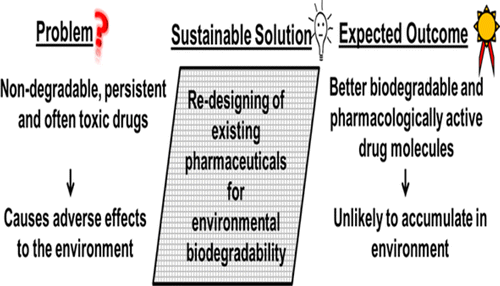Making pharmaceuticals that degrade before they can contaminate drinking water

In recent years, researchers have realized that many products, including pharmaceuticals, have ended up where they're not supposed to be—in our drinking water. But now scientists have developed a way to make drugs that break down into harmless compounds before they contaminate our taps. Their report appears in ACS' journal Environmental Science & Technology.
A wide range of active ingredients originating from pesticides, shampoos, lotions, cosmetics, disinfectants and drugs get washed into sewage systems or rivers and streams, ending up in our tap water. Scientists don't have a complete picture yet of what effects these substances have on wildlife and human health, but they are a major concern. Researchers have detected them in low levels in streams and rivers across the United States and in other countries. To address the specific problem of medications in the environment, Klaus Kümmerer and colleagues made tweaks to pharmaceuticals so they degrade after they've passed through both the body and sewage treatment systems, which aren't capable of scrubbing wastewater of all contaminants.
The researchers chose to work with a commonly used drug called propranolol—a beta blocker prescribed to treat high blood pressure and to prevent heart problems. It is very stable and has been found in sewage.
They made a small molecular change in its structure that didn't affect its beta blocking activity but allowed it to break down more easily than the original form. Further studies are needed, but initial testing showed that the altered drug and its byproducts are likely not toxic. The researchers suggest that a similar approach could be used to re-design other classes of drugs and chemicals to make them more environmentally friendly, too.
More information: Re-Designing of Existing Pharmaceuticals for Environmental Biodegradability: A Tiered Approach with ß-Blocker Propranolol as an Example, Environ. Sci. Technol., Article ASAP. DOI: 10.1021/acs.est.5b03051
Abstract
Worldwide, contamination of aquatic systems with micropollutants, including pharmaceuticals, is one of the challenges for sustainable management of water resources. Although micropollutants are present at low concentrations, many of them raise considerable toxicological concerns, particularly when present as components of complex mixtures. Recent research has shown that this problem cannot be sustainably solved with advanced effluent treatment. Therefore, an alternative that might overcome these environmental problems is the design of new pharmaceutical molecules or the redesign of existing pharmaceutical molecules that present the functionality needed for their application and have improved environmental biodegradability. Such redesigning can be performed by small molecular changes in the drug molecule with intact drug moiety which could incorporate the additional attribute such as biodegradability while retaining its pharmacological potency. This proof of concept study provides an approach for the rational redesign of a given pharmaceutical (Propranolol as an example). New derivatives with small molecular changes as compared to propranolol molecule were generated by a nontargeted photolysis process. Generated derivatives with intact drug moieties (an aromatic ring and a β-ethanolamine moiety) were further screened for aerobic biodegradability and pharmacological potency. The feasibility of the approach of redesigning an existing pharmaceutical through nontargeted generation of new derivatives with intact drug moiety and through subsequent screening was demonstrated in this study. Application of such approaches in turn might contribute to the protection of water resources in a truly sustainable manner.
Journal information: Environmental Science & Technology
Provided by American Chemical Society
















